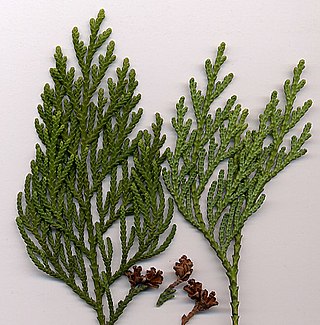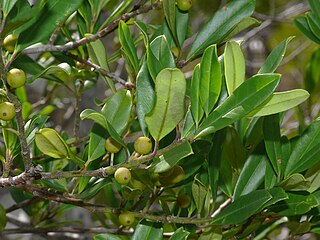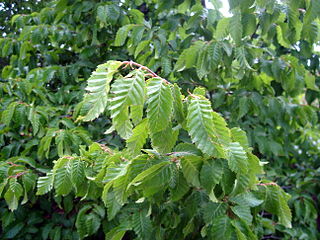
Dacrydium cupressinum, commonly known as rimu, is a large evergreen coniferous tree endemic to the forests of New Zealand. It is a member of the southern conifer group, the podocarps.

Thuja is a genus of coniferous tree or shrub in the Cupressaceae. There are five species in the genus, two native to North America and three native to eastern Asia. The genus is monophyletic and sister to Thujopsis. Members are commonly known as arborvitaes, thujas or cedars.
Cypress is a common name for various coniferous trees or shrubs from the Cupressus genus of the Cupressaceae family, typically found in warm-temperate and subtropical regions of Asia, Europe, and North America.

Platanus orientalis, the Oriental plane, is a large, deciduous tree of the Platanaceae family, growing to 30 m (98 ft) or more, and known for its longevity and spreading crown. In autumn its deep green leaves may change to blood red, amber, and yellow.

The London plane, or sometimes hybrid plane, Platanus × hispanica, is a tree in the genus Platanus. It is often known by the synonym Platanus × acerifolia, a later name. It is a hybrid of Platanus orientalis and Platanus occidentalis.

Araucaria heterophylla is a species of conifer. As its vernacular name Norfolk Island pine implies, the tree is endemic to Norfolk Island, an external territory of Australia located in the Pacific Ocean between New Zealand and New Caledonia. It is not a true pine, which belong to the genus Pinus in the family Pinaceae, but instead is a member of the genus Araucaria in the family Araucariaceae, which also contains the hoop pine. Members of Araucaria occur across the South Pacific, especially concentrated in New Caledonia, where 13 closely related species of similar appearance are found. It is sometimes called a star pine, Polynesian pine, triangle tree or living Christmas tree, due to its symmetrical shape as a sapling.

Platycladus is a monotypic genus of evergreen coniferous trees in the cypress family Cupressaceae, containing only one species, Platycladus orientalis, also known as Chinese thuja, Oriental arborvitae, Chinese arborvitae, biota or Oriental thuja. It is native to northeastern parts of East Asia and North Asia, but is also now naturalised as an introduced species in other regions of the Asian continent.

Ilex cassine is a holly native to the southeastern coast of North America that grows from Virginia to the Colorado River in Texas, with subspecies growing southward on the Gulf Coast as far as Veracruz, Mexico, and in Cuba, Puerto Rico, and the Bahamas in the Caribbean. It is commonly known as dahoon holly or cassena, the latter derived from the Timucua name for I. vomitoria.

Ilex vomitoria, commonly known as yaupon or yaupon holly, is a species of holly that is native to southeastern North America. The word yaupon was derived from the Catawban yą́pą, from yą- tree + pą leaf. Another common name, cassina, was borrowed from Timucua. The Latin name comes from an observation by early Europeans that the ingestion of the plant was followed by vomiting in certain ceremonies.

Chamaecyparis pisifera is a species of false cypress, native to central and southern Japan, on the islands of Honshū and Kyūshū.

Picea orientalis, commonly known as the Oriental spruce or Caucasian spruce, is a species of spruce native to the Caucasus and adjacent northeast Turkey.

The Oriental dollarbird is a bird of the roller family, so named because of the distinctive pale blue or white, coin-shaped spots on its wings. It can be found from Australia to Korea, Japan and India.

Carpentaria acuminata, the sole species in the genus Carpentaria, is a palm native to tropical coastal regions in the north of Northern Territory, Australia.

The African green pigeon is a species of bird in the family Columbidae, and one of 5 green pigeon species in the Afrotropics. The species has a wide range in Sub-Saharan Africa with around 17 accepted races.

The Javan ferret-badger is a mustelid endemic to Java and Bali, Indonesia. It is listed as Least Concern on the IUCN Red List and occurs from at least 260 to 2,230 m elevation in or close to forested areas.
Cassine viburnifolia is a species of mangrove plant of tropical Asia in the staff vine family Celastraceae. The specific epithet viburnifolia refers to how the plant's leaves resemble those of the genus Viburnum.

Carpinus orientalis, known as the Oriental hornbeam, is a species of hornbeam in the birch family Betulaceae, subfamily Coryloideae, native to southeastern Europe and Western Asia. It is quite tolerant of dry conditions, and usually occurs on hot dry sites at lower altitudes in comparison to Carpinus betulus. Together with C. betulus and Carpinus austrobalcanica, it is one of the three hornbeams native to Europe.

Cassine peragua, also known as Cape saffron, bastard saffron and forest spoonwood, is a medium-sized tree with fragrant flowers, decorative fruits and a saffron-coloured trunk. It is indigenous to the Afro-montane forests of South Africa.

Cassine is a genus of trees, of the plant family Celastraceae.

Elaeodendron melanocarpum is a species of shrubs or small trees endemic to northern Australia. The natural range extends from The Kimberley across The Top End to Cape York Peninsula and southwards to South East Queensland. The species occurs in monsoon forest and drier types of rainforests, commonly along streams.




















